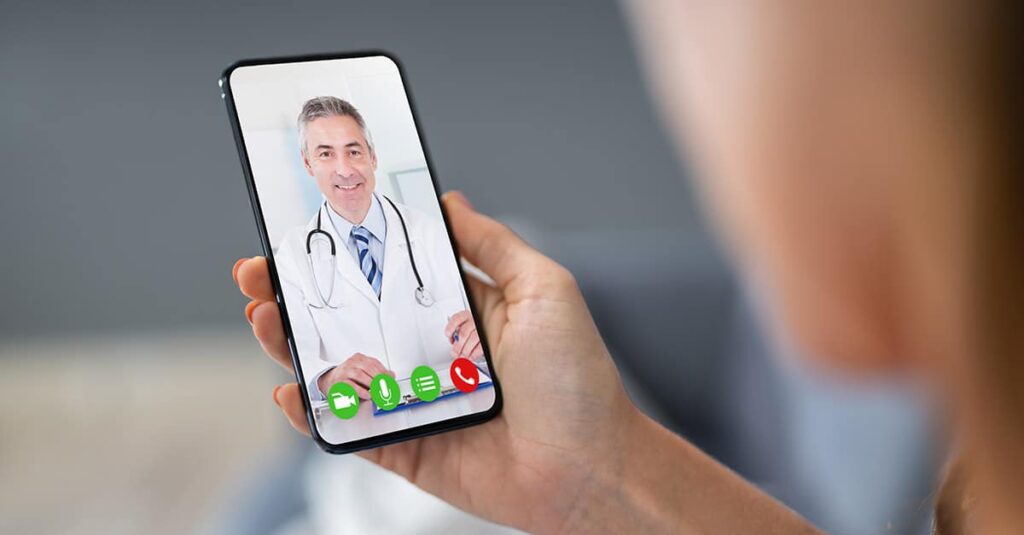As the COVID-19 health crisis continues to change our way of life, hospitals and health systems need to accommodate to the growing needs of their communities. However, they must tend to their patients in a way that’s mindful of current safety and social distancing measures. Indeed, the need to leverage care during a pandemic is practically forcing organizations to “Healthcare Differently.” Among the ways hospitals are working to meet this need is with a greater focus on telehealth services, bringing the doctor’s office to the comfort and safety of one’s home.
Telehealth is far from being a new concept in the world of healthcare, with people exploring its potential throughout the history of telecommunications. In addition to at-home consultations that many people think of when they hear “telehealth,” it can also take the form of patients going to a hospital to speak to off-site specialists with their primary care provider. Moreover, telehealth’s often used in small and rural communities with limited resources, combatting healthcare disparities by making it easier for people to receive the care they need.
According to our latest National Healthcare Consumer Study, telemedicine usage more-than-doubled from our previous edition of the study (jumping from 6% to 15%). Two-thirds of consumers rate their telemedicine experience as “excellent” or “very good,” and nearly half (48%) of respondents would be willing to substitute traveling to see a specialist with telehealth arrangements. Speaking to telehealth’s capabilities, Trevor Turner, MD, FAWM, a PRC Excellence Accelerator® coach, remarks that “patients appreciate the opportunity [to avoid] the average 2.5 hours of door-to-door time just for a couple of minutes with an Orthopedic... Hence, the use cases for routine post-op checks of wounds and other visits like image review are well suited to adoption by doctors for the telemedicine.”
Even though telehealth isn’t new, its growing popularity still makes it feel like it’s emerged in the right place at the right time. Patients don’t need to leave their homes to attend appointments, while doctors and staff are able to connect with patients without the risk of exposing themselves to illness. As previously mentioned, care coordination with off-site specialists is made easier through telehealth connections, and in the midst of COVID 19, the same degree of coordination in telehealth’s absence is nearly impossible. Further, with symptom surveys and digital follow ups, telehealth opens the door to a feedback loop that’s hard to replicate when repeatedly scheduling physical visits.
Luckily, it’s not just PRC recognizing how telehealth can be utilized during these trying times. A study reported in Health IT News found two-thirds of participants to be more willing to try telehealth because of COVID-19. The FCC’s COVID-19 Telehealth Program is set to issue $200 million in telehealth funding. Health insurance providers are adjusting policies to better accommodate telehealth. Meanwhile, updates to Medicare now declare that telehealth has the same rates as in-person appointments, while also lightening up restrictions that determine telehealth eligibility for patients.
All things considered, telehealth offers one of the greatest opportunities for hospitals to continue administering care in a time of social distancing, continued uncertainty, and high demand. Some have speculated that telehealth’s popularity may sustain itself beyond the current pandemic, continuing to be a viable alternative to in-person visits. In that regard, Bob Kocher, MD, a member of California’s private COVID-19 taskforce, writes “virtual care will become a much more integral part of healthcare for all of us, and this will lead to better care and more accessible care.” Similarly, Dr. Turner concludes that “telehealth is here to stay after forced adaptation from the COVID-19 pandemic,” and that organizations who leverage its capabilities will emerge from the pandemic “leaner and more efficient than ever before.”
To accompany telehealth’s growth, PRC offers research that measures the telehealth experience. If you’re ready to measure excellence in your telehealth program, contact us today at [email protected].
Sources and Further Reading:
COVID-19 is normalizing telehealth, and that’s a good thing
COVID-19 Telehealth Program
Survey: Americans’ perceptions of telehealth in the COVID-19 era
Telehealth in the time of COVID-19
What is telehealth? How is telehealth different from telemedicine?

